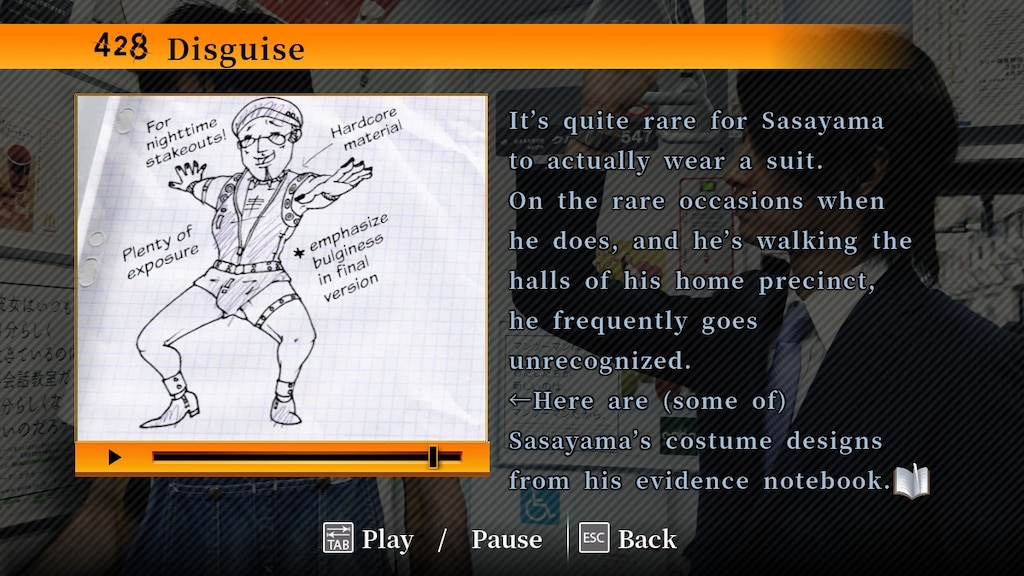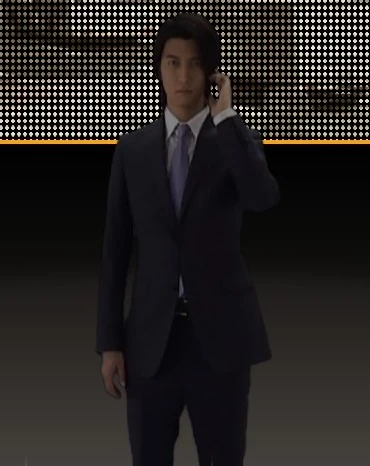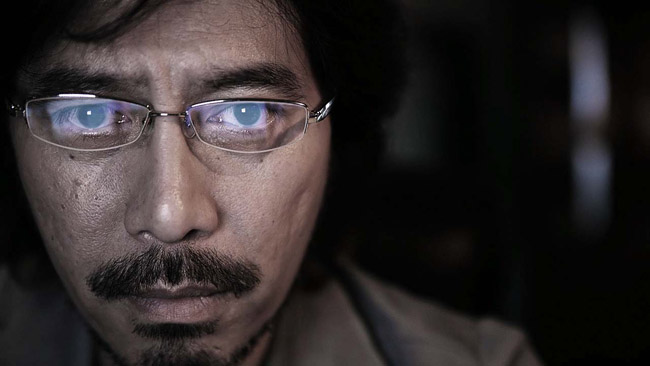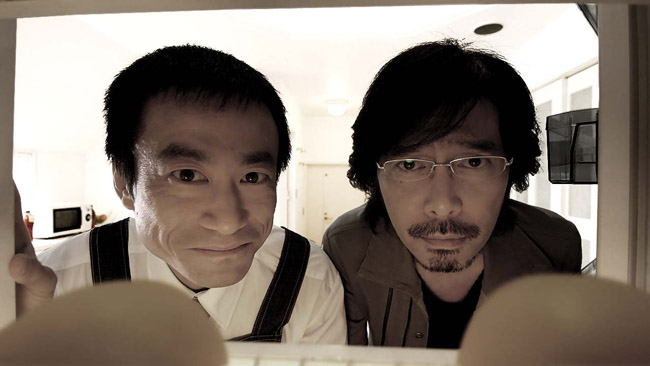This is all a preface to why I bothered with the visual
novel 428: Shibuya Scramble. The game
has long walls of text and essentially no gameplay so there would have to be
something major to set it apart and at a glance that something isn’t apparent. There is one very important person who made
this a must-buy: Yukinori Kitajima.
I’ve mentioned Kitajima more than once on this blog. He’s the writer of the excellently written
Senran Kagura games, the 3DS Ace Attorney games (including working with the
Professor Layton writer in their crossover), the underrated Okamiden and at
least contributed to the aforementioned 999.
Before all of those, Kitajima’s claim to fame was 428. It was originally released on the Wii in 2008
and was showered with praise, being one of the very few games/visual novels to ever get a
perfect score in the Japanese gaming magazine Famitsu. After the initial release it was ported to
the PS3, PSP and iPhones to reach even more players.
In Japan
And nowhere else.
It took a full decade for it to finally come out in America
As much as Spike Chunsoft should be given credit for releasing it, they made some big mistakes with their release of 428. For one, there was next to no advertizing. I didn’t even know it was out until two months later when I came across it on the Steam store and almost had a heart attack. There’s also not a single bit of marketing on the store page noting Kitajima’s involvement as the writer. He’s almost the only reason I bought it! Why would you not want to draw attention to someone with that kind of notoriety?
All of that is nothing when compared to the biggest problem. Spike Chunsoft only
released 428 on the PS4 and PC.
Nothing else. There were already
ports on the PS3, PSP and Wii, but instead of all of those, they decided the
only game console version should be one of the worst game systems
available. Even if they went with the PS3 instead of the PS4, that wouldn’t change that it’s also not
available portably. Visual novels take a
lot of time to get through so they’re ideal to take out and read on the
go. That’s why the DS, 3DS and
especially the Vita have so many. If
they could fit it on a PSP, then the Vita and maybe the 3DS could handle it. They didn’t even bother with the iPhone
port. It’s inconceivable why they
wouldn’t make a portable option for this extremely long visual novel.
At least the PC version can be played by just about anyone
who owns one. Because of its nature as a
visual novel, it doesn't take much to run, even for the lowest end PCs. For me it only chugged on a few areas of one
particular menu for selecting where to start reading from. Once the actual
visual novel started, it ran perfectly.
As long as your computer can play videos, it can run 428 and should because this is one beast of a visual novel.
428: Shibuya Scramble is easily the biggest, most ambitious
and probably most expensive visual novel I have ever seen. This the Ben Hur or Resident Evil 6 of visual
novels. With most visual novels, characters with still images and/or
limited animation are put behind text, but 428 takes that visual standard and
throws it out the window. Through the
entire run, from beginning to end, the story is told through still pictures of
live action actors that are ever-changing and never reused. It’s like a slideshow of an FMV game with a handful of instances of actual FMV.
Every single image is excellently shot with use of depth of field, rule
of thirds and is always at the perfect moment and angles, be it action scenes
or suspenseful ones. The photographers
were clearly professionals and considering 428’s length, it had to have cost a
pretty penny.
428 has the length of a JRPG, taking over 40
hours at least and all of those hours is text and high quality photography. I can see why it was left untranslated for so
long. It must’ve been a titanic
undertaking. It may not have been
terribly expensive to translate the text to English, but the time it had to
have taken for all of it and replacing all the Japanese text must’ve been
unreal. This isn’t just a visual
novel. This is the visual novel. Written by
the Yukinori Kitajima.
The story it tells has often been compared to 24. It takes place over the course of 10 hours
and follows the perspective of 5 different characters whose stories intersect
over the course of the overall plot. My
saying it’s the Resident Evil 6 of visual novels was not just referring to the
production values.
It starts with a kidnapping case in which a girl named
Hitomi is specifically asked by the kidnappers to drop off the briefcase with
their ransom at the statue of Hachiko.
The kidnappers run off with the briefcase and the chase is on. From there the story evolves into a
complicated plot involving an international crime syndicate, a street gang rife
with in-fighting, loan sharks, bioterrorism and a mysterious Middle Eastern
woman. Each character’s story has their
own focus as everything is going on.
One of the officers assigned to the kidnapping case is Kano Kano Kano
The local Shibuya teen Achi gets involved in the story
inadvertently. When he sees Hitomi in
trouble, he runs away with her through the streets of Shibuya and much of his
story is the both of them being on the run from a mysterious gunman with a cane. Achi used to lead the local group of upstarts
that were previously nothing more than a group of friends in Shibuya, but after
he left it since evolved into a street gang bitter about his leaving. Achi was born and raised in Shibuya so he’s
very street smart, knows his way around and is also a good fighter, which helps
when trying to get rid of pursuers and aggressors.
Minoru Minorikawa is the comically hot-blooded freelance journalist
working for a local gossip magazine. His
editor owes the local Yakuza a great deal of money and is forced to run and
hide from them when they come to collect. The editor can’t afford a functioning staff, but Minorikawa takes
control for the next issue. Minorikawa believes
that if he can get the next issue out by the deadline the collectors will
believe they can come up with more income and give them more time. Much of his story is traveling Shibuya to get
interviews and scoops for the magazine while the editor is chased all over the
city.
It’s also mostly him pointing and yelling at
everything. He loves to point and
yell. Ace Attorney characters don’t
point and yell this much. He even points
and yells at inanimate objects!
The seemingly odd one out of all the characters is Tama, an
amnesiac girl trapped in a cat mascot suit tasked with selling a dollar store
diet drink called Burning Hammer for an inflated price at the behest of a local
shyster named Yanagishita. Yanagishita
keeps falling for get rich quick schemes that put him in debt and he’s on the
run from the very same collectors chasing Minorikawa’s editor. He is a very silly character and his actor
mugs at the camera for all he’s worth.
Tama works with him because he promised her payment that
would let her afford a familiar necklace a local secondhand shop is selling. She becomes much more important later, but I
won’t go into detail on that.
Finally there’s Kenji Osawa, a local virologist and the
father of Hitomi. Osawa is a virologist
who receives a threatening e-mail regarding a super virus with a high mortality
rate he worked on previously. Through
his story he works closely with the police at his house to keep track of his
daughters’ whereabouts while unraveling clues as to the virus and the secrets
of the people around him. He works in
particular with a very eccentric detective who has very strange mannerisms,
but is multitalented and befriends Osawa.
That’s the main characters, but 428 has tons of interesting
side characters. Osawa’s wife, the
police chief, Kano's detective inspiration, the secondhand shop's owner and Yanagishita come to mind. It’s a story where everyone is full of character, even when they aren’t given much screen time.
It’s the kind of fun background characters you’d see in something like the Persona
games.
My favorite is definitely Yukinori Kitajima.
 |
| I want to play it! I want to play it! |
The separate character stories themselves don’t interact
much for most of the overall story. Until the
plot thickens, they largely interact passively, seeing each other on the
streets, maybe exchanging a few words without knowing what the other is really
doing and, most importantly, impacting the other stories indirectly.
This is where the closest thing to gameplay 428 has comes
in. At points in a story, characters
have choices they can make that affect the others. If you don’t make the right choices with the
right characters, you get a bad ending, which range from absurd to nightmarish to
absurdly nightmarish. After the bad
ending, it gives you a hint as to what to do in order to prevent it from
happening, at least until the very end when the hints stop.
 |
| A bad ending. |
For example, at one point in Tama’s story you have the
choice of giving your sample of Burning Hammer to a man that, if you played Kano
I should complain that seemingly innocuous choices cause a
game over, but the bad endings are part of the fun instead of a punishment. Since you can jump to any choice, it’s not
frustrating to simply go back and change it and it gets a lot out of this
simple mechanic through experimentation and seeing what could change.
The interactive element is divided by its 10 hours. If you make a choice in one hour, you can
only get the bad ending in that hour.
You move onto the next hour once everyone reaches their own “to be
continued” point, which is a great structure.
I’m not as big a fan of the “keep out” system though.
At several points, a character’s story will stop your
progression by putting “keep out” police tape on the time slot. You break it and proceed by doing what is
called “jumping” in another character’s story.
When a character is brought up in another story, their name appears in
red and underlined, at which point you can select it and jump into their story
right there. It’s like a different means
of the “to be continued” system, where it doesn’t want to reveal too much when
another character isn’t there yet. It
seems like a good idea on paper, but in practice, it’s intrusive. 428 is already organized fine by going one hour
at a time. This gives two kinds of
interruptions: one with the tape first appearing and one in the middle
of a story and you jump to another one.
The only other nominal interaction is the term
descriptions. Certain terms will be blue
and underlined. By selecting them, 428 gives a description of what the terms mean. Sometimes it’s figures of speech, locations
in Shibuya, how the Japanese police system works and elaborations on side
characters in the story. It has
two icons to differentiate what’s fictional and what’s from real life too,
which is a neat touch. There’s some
interesting bits in them and they briefly break things up, but are usually
optional. They’re only required on the
few times one of the previously-mentioned red text you need to jump comes up in
them.
 |
| I imagine that one would be hard to make. And gay. |
All of that is almost meaningless when a visual novel lives
and dies by the story and the bottom line is that the story is excellent and
when coupled with the photography and sound direction it’s downright
marvelous. 428 is a master class in
plotting, twists, character development, emotional storytelling through visuals
and music, setting things up to use later and the comedy style of bathos.
In stories like the Ace Attorney and Senran kagura games,
there is a time for jokes and a time to be serious that it switches between. In 428, the humor and silliness is interwoven
into the plot and characters in such a way that it’s harder to tell when
something is funny because it’s supposed to be, giving it a surreal edge that
also makes it flow better. That is what
I see as bathos.
Every key character’s interactions and histories are
detailed and relationships are built excellently, as one would expect from the
writer of the Senran Kagura games.
Minorikawa and his editor, Osawa and the detective and Achi and Hitomi
are great at playing off each other and supporting each other with relationships that cement who they are and always make a feel good situation
even in the worst of times. By the end, the characters all start coming together in a finale that’s nothing
short of fantastic. At least, half of
it.
There are a few points to nitpick where it feels like 428
kind of drops the ball and one half of the finale is one of them. At that point there are two plotlines going
on and one of them goes out with less flair than I would have liked, in
both the slightly different endings possible.
The conclusion of the other definitely makes up for it though. Also, without spoiling it, the reason behind
Tama’s amnesia is only briefly mentioned and for such a big plot point, kind of
disappointing.
I never quite bought the acting from the CIA agent Jack
Stanley either. The Japanese actors are
great at showing their facial emotions, but Stanley always seems to be acting
and posing as instructed rather than coming off naturally and if that was
supposed to be the idea, it came out wrong.
His actor (and another American actor involved) has more credit in
motion capture for Japanese games rather than facial acting so it’s clear one
of the more important factors in his casting was that he was a Japanese
resident. Knowing that, it’s
understandable why it turned out this way, considering they were probably
already breaking the bank without flying in Hugo Weaving and the character is still written well.
The complaints I have are minor in the grand scheme of
things. If I ever use the term
“masterpiece” to describe a straight standalone visual novel, it will probably
be this one because it is one of the best written stories in anything I have
ever read, but that's moreso the original Japanese
version. The translation is a little…
Off.
From what I understand, the translation is very faithful and I know beggars can’t be
choosers considering how much effort they must’ve poured into it, but it’s not
a perfect translation.
I haven’t read the original Japanese text (I can barely read
kanji), but I’m pretty sure nobody in Japan uses any term like “flim-flam” as a
real insult or figures of speech exclusive to the English language. It takes me
out of the setting. It seems as though
they also replaced the blue text description for these instances with the
origins in the English language. It’s
still interesting for English players, but I would’ve preferred they try
to keep in the quirks of Japanese language and use those descriptions for information
about that instead.
There are also way too many typos. I was willing to overlook it the first few
times, but after about 10 or 15 instances of a repeated word, missing space
between two words or a misplaced letter, it got annoying to the point I was groaning
by the end.
It almost reads like it was
all done on one draft with only the bare minimum of proofreading. It never impacts the storytelling to a
significant degree (this isn’t Ignition Entertainment) and that I can
sing praises for the writing speaks to that they translated it well enough to
still be good, but it really needed another look-over.
Even for the best visual novel ever made, it’s
understandable that some readers still might think paying 50 dollars (30 if you
can get it on sale) is asking too much, but for 428 it is absolutely worth
it. It’s expected for visual novels to
have replay value through possible routes from the choices you make. 428 does have this in the form of the bad
endings, which are treated as collectibles you can get achievements for, but it
takes the replay value even further than that and adds on what’s almost another
visual novel’s worth of content.
In addition to this tour de force being roughly 40 hours on its own, there are bonus scenarios you can find by going back to specific parts of the story and finding hidden codes you miss the first time and by passing a quiz asking about specific minor details from the story. You will likely need a guide or help online for a few, however. After getting the right endings, there are also two particularly special extra visual novels added on. Unlike the main story, they aren’t written by Yukinori Kitajima. One of them is a side story involving a certain character in the main story that didn’t have any direct involvement, while the other is a big setup for the anime sequel seriesCanaan , written by Kinoko Nasu, writer of the likes of
the Fate series and Tsukihime. They
don’t have the choice system like in the main story, but they’re both nice
standalone side stories that are a couple hours long each.
In addition to this tour de force being roughly 40 hours on its own, there are bonus scenarios you can find by going back to specific parts of the story and finding hidden codes you miss the first time and by passing a quiz asking about specific minor details from the story. You will likely need a guide or help online for a few, however. After getting the right endings, there are also two particularly special extra visual novels added on. Unlike the main story, they aren’t written by Yukinori Kitajima. One of them is a side story involving a certain character in the main story that didn’t have any direct involvement, while the other is a big setup for the anime sequel series
With all that value in one visual novel, I cannot recommend
428: Shibuya Scramble enough. It’s
practically the ultimate visual novel.
Even if you don’t read visual novels, everyone should read
this one. Spike Chunsoft could have not
bothered with translating it, considering it’s a decade old, but they did because
they knew they had gold on their hands.
It is one of the best written experiences I have ever gone through, and I seem to say
that about a lot of games these days (a good sign of the state of the medium),
but for 428, with the storytelling in every facet of its design, it’s only
fitting it would succeed in that respect with flying colors. It’s not just good. It’s Yukinori Kitajima good. I give 428: Shibuya Scramble a 9 out of 10.













No comments:
Post a Comment